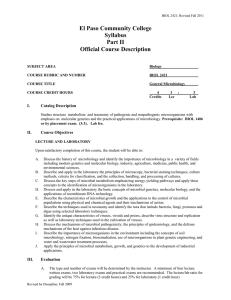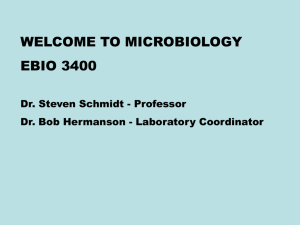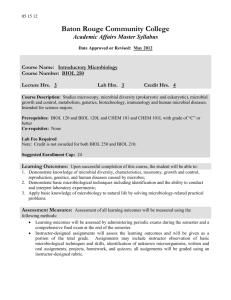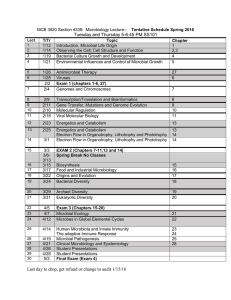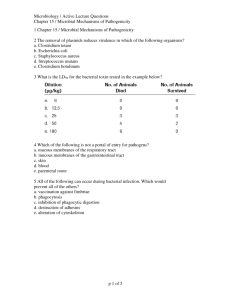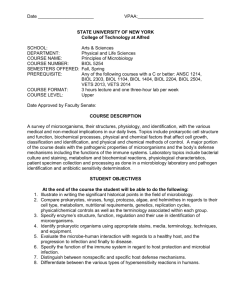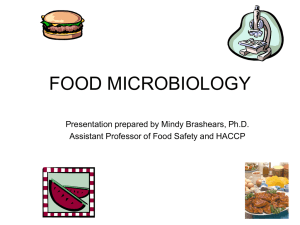El Paso Community College Syllabus Part II Official Course Description
advertisement
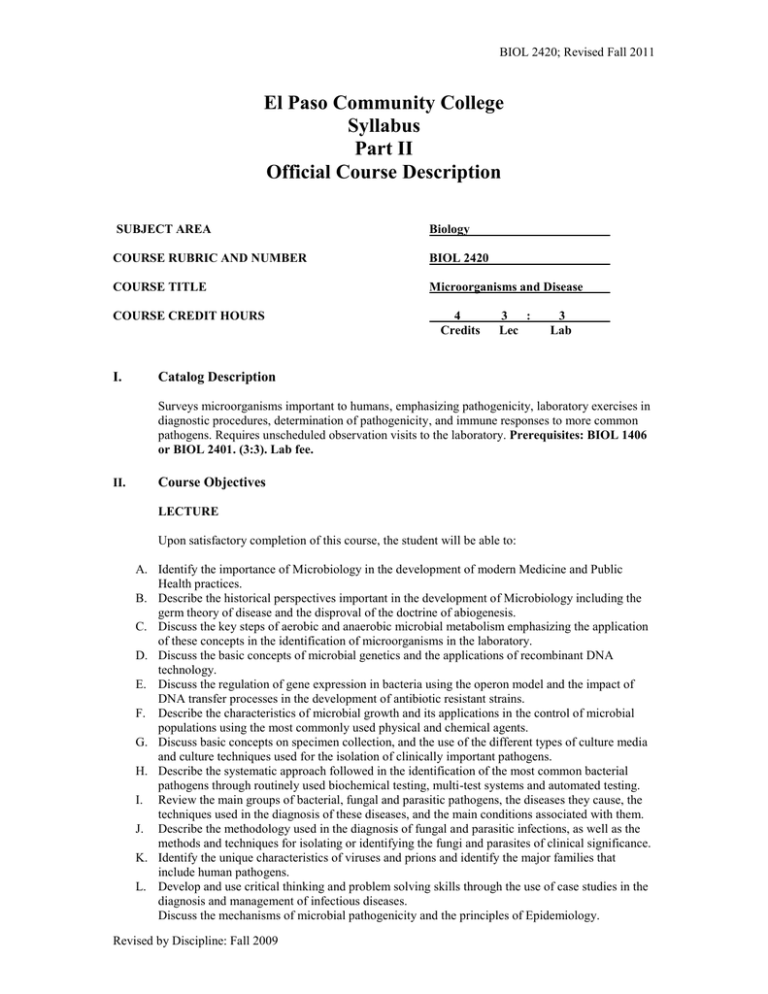
BIOL 2420; Revised Fall 2011 El Paso Community College Syllabus Part II Official Course Description SUBJECT AREA Biology COURSE RUBRIC AND NUMBER BIOL 2420 COURSE TITLE Microorganisms and Disease COURSE CREDIT HOURS I. 4 Credits 3 : Lec 3 Lab Catalog Description Surveys microorganisms important to humans, emphasizing pathogenicity, laboratory exercises in diagnostic procedures, determination of pathogenicity, and immune responses to more common pathogens. Requires unscheduled observation visits to the laboratory. Prerequisites: BIOL 1406 or BIOL 2401. (3:3). Lab fee. II. Course Objectives LECTURE Upon satisfactory completion of this course, the student will be able to: A. Identify the importance of Microbiology in the development of modern Medicine and Public Health practices. B. Describe the historical perspectives important in the development of Microbiology including the germ theory of disease and the disproval of the doctrine of abiogenesis. C. Discuss the key steps of aerobic and anaerobic microbial metabolism emphasizing the application of these concepts in the identification of microorganisms in the laboratory. D. Discuss the basic concepts of microbial genetics and the applications of recombinant DNA technology. E. Discuss the regulation of gene expression in bacteria using the operon model and the impact of DNA transfer processes in the development of antibiotic resistant strains. F. Describe the characteristics of microbial growth and its applications in the control of microbial populations using the most commonly used physical and chemical agents. G. Discuss basic concepts on specimen collection, and the use of the different types of culture media and culture techniques used for the isolation of clinically important pathogens. H. Describe the systematic approach followed in the identification of the most common bacterial pathogens through routinely used biochemical testing, multi-test systems and automated testing. I. Review the main groups of bacterial, fungal and parasitic pathogens, the diseases they cause, the techniques used in the diagnosis of these diseases, and the main conditions associated with them. J. Describe the methodology used in the diagnosis of fungal and parasitic infections, as well as the methods and techniques for isolating or identifying the fungi and parasites of clinical significance. K. Identify the unique characteristics of viruses and prions and identify the major families that include human pathogens. L. Develop and use critical thinking and problem solving skills through the use of case studies in the diagnosis and management of infectious diseases. Discuss the mechanisms of microbial pathogenicity and the principles of Epidemiology. Revised by Discipline: Fall 2009 BIOL 2420; Revised Fall 2011 M. Describe the manner in which nonspecific and specific host defense mechanisms are involved in fighting back pathogens and protecting the host from infectious diseases. N. Apply the principles of immunology to the diagnosis, prevention and treatment of infectious and immune diseases. O. Discuss the main methods of antibiotic susceptibility testing and the application of the main antimicrobial agents. LABORATORY A. Understand and comply with laboratory safety rules and procedures, and universal precautions. B. Describe the light compound microscope and become proficient with its use. C. Understand the use of the different modifications of the light compound microscope and compare light microscopy with electron microscopy. D. Describe and perform some of the most widely used stains and wet mounts with emphasis in the gram stain. Discuss their significance in the identification of microorganisms. E. Perform basic Microbiology procedures for the transfer, isolation and observation of some of the most commonly encountered bacteria of clinical significance. F. Understand the use of the different types of bacterial culture media in facilitating the growth, isolation, and identification of different organisms. G. Perform basic bacterial identification procedures using conventional biochemical testing and a multi-test system. H. Learn basic identification protocols based on organism microscopic morphology for some of the common fungi and parasites. III. Evaluation The type and number of exams will be determined by the instructor. A minimum of four lecture written exams, two laboratory exams and practical exams are recommended. The lecture/lab ratio for grading will be 75% for lecture (3 credit hours) and 25% for laboratory (1 credit hour) Grading scale: 90 –100 = A 80 –89 = B 70 –79 = C 60 –69 = D Below 60 = F IV. Disability Statement (American with/Disabilities Act [ADA]) EPCC offers a variety of services to persons with documented sensory, mental, physical, or temporary disabling conditions to promote success in classes. If you have a disability and believe you may need services, you are encouraged to contact the Center for Students with Disabilities to discuss your needs with a counselor. All discussions and documentation are kept confidential. Offices located: VV Rm C-112 (831-2426); TM Rm 1400 (831-5808); RG Rm B-201 (831-4198); NWC Rm M-54 (831-8815); and MDP Rm A-125 (831-7024) V. 6 Drop Rule Students who began attending Texas public institutions of higher education for the first time during the Fall 2007 semester or later are subject to a 6-Drop limit for all undergraduate classes. Developmental, ESL, Dual Credit and Early College High School classes are exempt from this rule. All students should consult with their instructor before dropping a class. Academic assistance is available. Students are encouraged to see Counseling Services if dropping because exemptions may apply. Refer to the EPCC catalog and website for additional information. Revised by Discipline: Fall 2009
